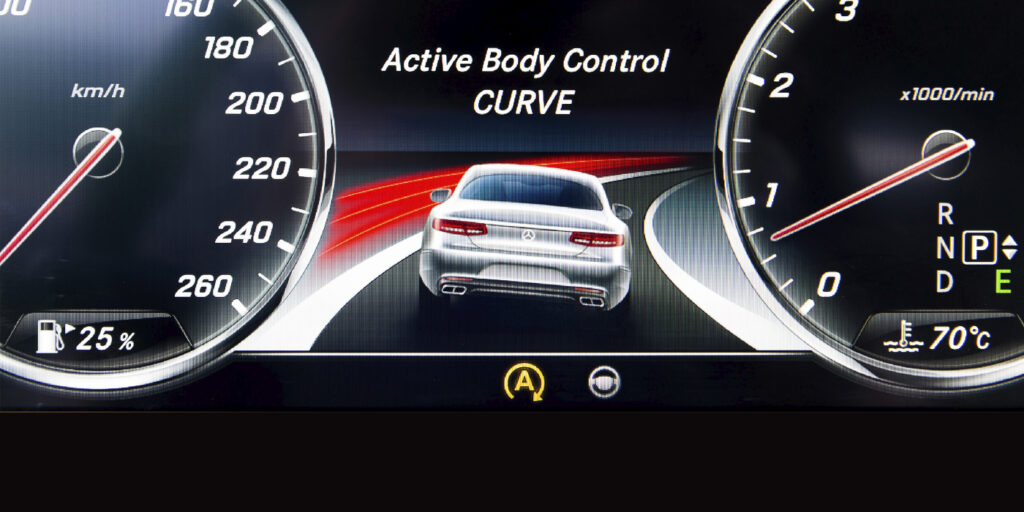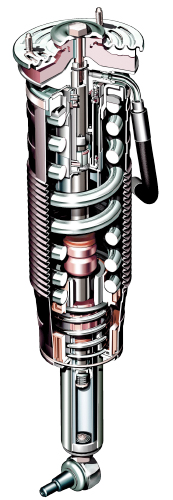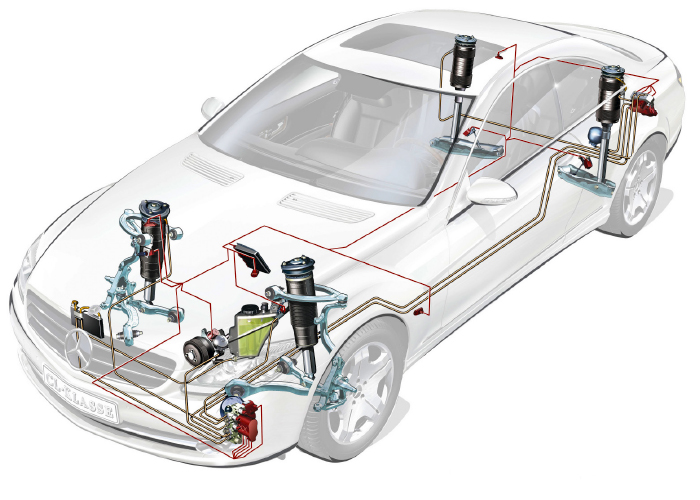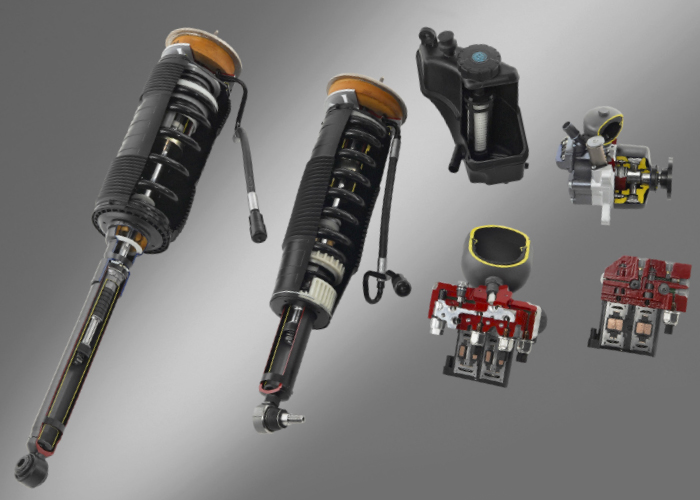Mercedes-Benz’s Active Body Control (ABC) has been around since 1999. It is essentially two suspensions in one. The system uses a hydraulic cylinder on top to control the low-frequency movements of the suspension like body roll and brake dive. Below the hydraulic part is a conventional spring and dampener that can adjust rebound and compression.
The system provides great ride and handling, but it can be complicated to service if you do not have the right tools, training or knowledge of the tips down below.
Use a Scan Tool
You can’t fully service an ABC suspension without a scan tool. There are non-factory scan tools that can perform a task like “rodeo mode” and bi-directional functions to refill and diagnose the system. Most of the common failures on ABC systems are sensors, and you need a scan tool to access the suspension control module.
There is a myth out there that if an ABC system is malfunctioning, a tech can flush the fluid and perform an aggressive test drive involving cornering hard and going over speed bumps that will free trapped debris in the valves. This type of driving is dangerous. The rodeo mode that actuates the suspension in the bay is far more effective and less risky.
2. Keep It Clean
Even the smallest piece of debris or dirt can cause the system to malfunction. The most common debris in the system is usually small pieces of rubber from the solenoid valves and accumulators. These seals can degrade due to age and the extreme pressure generated by the system. The debris will stick to the plunger or seat of the valves that control the suspension.
This obstruction will cause the suspension to raise or lower depending on whether the inlet or outlet valve is leaking internally. When this happens, the suspension will raise or lower and then be corrected by the system to return it to a normal height. This behavior might take seconds or minutes, depending on the size of the internal leak.
The best practice is to clean the area around a line with a brush and aerosol brake clean before it is removed to avoid any contamination. The same is true for the reservoir and cap. When the line is replaced, make sure the fitting and mating surfaces are clean.
3. Know the Modes
The system has two modes, active and passive. The active mode starts when the car is shifted out of park. This mode controls the attitude and dampening of the vehicle. Passive mode starts when the car is shifted into park and levels the car as people get in or out, or when heavy items are put into the trunk.
Knowing the modes is critical to understand because making a diagnosis when the vehicle is in park might not be the same as if the system were in drive. In some cases, a data PID for the gear lever position sensor can cause ABC problems.
When the ABC suspension warning light is on, the suspension is in a limp mode, and valves to the struts are locked closed. That way, a leaking strut will not cause the other struts to leak down.
4. Replace the Filter
There is a filter inside the reservoir that should be replaced any time the system is repaired or when maintenance is performed. This filter can trap particles between 3 to 10 microns in size. To put that into perspective, the average human hair is 50 microns wide and most oil filters can filter out particles that are between only 20 to 40 microns in size.
5. Topping the Fluid
It is a common mistake for owners to overfill or underfill the reservoir. The fluid level should be checked when the trunk is empty, the fuel tank is full, and the car is parked on a level surface. If the trunk is full of heavy items, the fluid in the reservoir might read below the “MIN” level on the dipstick. If the suspension is down or the car is parked on a grade, the fluid may read higher than normal.
6. Inspecting the Lines
The lines for the ABC system are subjected to pressures as high as 3,000 psi. Some leaks in the soft and hard lines can be impossible to see. The fluid used by Mercedes-Benz does not have fluorescent dyes from the factory. But, there are dyes available that are safe to add to the system if you follow the directions and do not add too much. If you are looking for a tiny leak, try spraying aerosol foot powder in the area. The powder in that area will absorb the leak.
7. Random Height Changes? Check the Accelerometers
The ABC suspension system uses multiple accelerometers to measure the movement of the body during cornering, braking and acceleration. Other accelerometers measure how the body is moving up or down relative to the movement of the wheel assembly. If one of the sensors is damaged or producing faulty signals, it can cause erratic operation of the suspension.
If you receive customer concerns of the vehicle’s suspension level randomly lowering while driving or rapid sporadic level changes shortly after stopping the car, look at the data from the sensors to see if the values change when the car is sitting still while in gear. If the values fluctuate, inspect the sensor. If the sensor is replaced, check the service information to see if it needs to be calibrated.
8. Know the Noise
ABC suspension systems can have noise problems that sound a lot like a power steering complaint. It is usually a humming or howling noise that can come from under the car, but does not stop at the firewall. It is typically heard at idle up to 2,000 rpm. The sound will be drowned out by engine and road noise. This failure is common on cars with more than 60,000 miles. The most common cause is the pulsation dampener that is typically found on the line going from the pump to the front solenoid block. This dampener is engineered to smooth out the pressure changes caused by the pump and movement of the suspension.
If the noise is still present, it could be a symptom of a failed or failing accumulator, or a hydraulic line that is in contact with the body. You might get a car in with low system pressure codes. Your first instinct might be to replace the pump, but it could be the accumulators. If the pump can survive the rodeo mode test with a scan tool, chances are nothing is wrong with the pump. This is also why you need a scan tool that does more than pull codes for these vehicles.
There are three accumulators on ABC-equipped vehicles. Each valve block has an accumulator along with the return line. Each accumulator has a diaphragm with hydraulic fluid on one side and high-pressure nitrogen on the other. The accumulator supplements the pressure and fluid volume provided by the pump in cases where the suspension has to do a large correction.
It is impossible to visually inspect an accumulator when it is on the vehicle. But it is better to remove the accumulator to make sure the nitrogen gas is pressing the diaphragm against the port.
ABC Replacement Options
With the ABC suspension, there are a lot of replacement options. But, before you write up the estimate, make sure you have performed a complete inspection of the system. If a comprehensive assessment of the system is not conducted, what appeared to be a worn strut can quickly turn into an accumulator and pump replacement.
The other key is to understand the customer and their expectations of the final repair before they drive away from your shop. Never lead with the least expensive repair option first; oftentimes, this repair does not fulfill the customers’ needs.
Realize that ABC units can wear out before they leak. Under the plastic shields and bellows are a conventional spring and dampener that are subjected to the same forces as non-ABC equipped Mercedes-Benz models. Also, on models with the Active Dampening System (ADS), the valving and electric actuator can fail.
Remanufactured replacement units are available at a significantly lower cost when compared to new units. When replacing ABC struts make sure to replace them in pairs, as the opposite side has traveled the same distance over the same roads.
A conversion kit that changes the ABC system into a passive system with springs can be sourced. Make sure you explain to the customer what they are losing regarding ride quality, handling and functionality. The change from the ABC to passive struts and springs can leave some customers missing the old system.

















